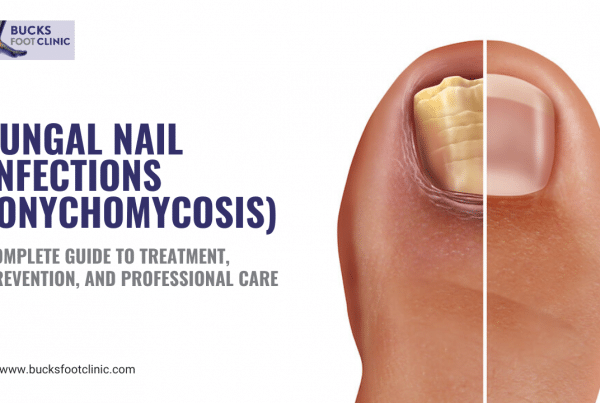
Diabetic Foot Care: 5 Essential Tips to Avoid Complications
Living with diabetes requires vigilant attention to many aspects of your health, but few areas demand as much careful monitoring as your feet. Diabetic foot complications affect approximately 15-25% of people with diabetes during their lifetime, yet many of these serious issues are entirely preventable with proper care and professional guidance. This comprehensive guide provides essential diabetic foot care tips that can help you maintain healthy feet, prevent ulcers, and avoid the devastating complications that too often lead to hospitalisation or amputation.
Understanding Why Diabetic Foot Care Is Critical
Diabetes affects your feet through two primary mechanisms that work together to create a perfect storm of potential complications. Firstly, peripheral neuropathy—nerve damage caused by prolonged high blood sugar levels—reduces sensation in your feet. This means you might not feel cuts, blisters, or pressure points that would normally alert you to problems. Secondly, diabetes compromises blood circulation, particularly to the extremities, which slows healing and increases infection risk.
When you cannot feel injuries and your body struggles to heal them, even minor issues can escalate rapidly. A small blister from ill-fitting shoes can progress to an ulcer, which may become infected and, in severe cases, lead to amputation. In the UK, diabetes-related amputations occur every two and a half hours—a sobering statistic that underscores the importance of preventive care.
The economic and personal costs of diabetic foot complications are staggering. Beyond the obvious health implications, foot problems can limit mobility, reduce independence, and significantly impact quality of life. However, research consistently shows that up to 85% of diabetes-related amputations could be prevented through proper foot care and early intervention.
The 5 Essential Tips for Diabetic Foot Care
- Perform Daily Foot Inspections
Make examining your feet part of your daily routine, ideally at the same time each day to establish consistency. Check every surface of both feet, including between your toes, the soles, heels, and sides. Look for cuts, blisters, redness, swelling, bruises, or any changes in skin colour or temperature. Pay particular attention to areas where shoes might rub or create pressure points.
If you have difficulty seeing the bottoms of your feet due to mobility issues or vision problems, use a hand mirror or ask a family member for assistance. Some people find taking photographs with their mobile phone helpful for comparing changes over time. Document any concerns in a diary, noting the location, appearance, and date of discovery.
- Maintain Meticulous Hygiene
Wash your feet daily with lukewarm water and mild soap, testing the water temperature with your elbow or a thermometer rather than your feet, as neuropathy can impair your ability to detect dangerous temperatures. Water should be between 30-35°C to avoid burns. Gently clean between your toes and around your nails, but avoid soaking your feet for extended periods, as this can lead to maceration and increase infection risk.
After washing, dry your feet thoroughly, paying special attention to the areas between your toes where moisture can accumulate and create an environment conducive to fungal growth. Apply a quality moisturiser to prevent dry, cracked skin, but avoid applying cream between your toes, as excess moisture here can promote fungal infections.
- Choose Appropriate Footwear and Socks
Invest in properly fitted shoes that provide adequate support and protection without creating pressure points. The best time to shop for shoes is in the afternoon when your feet are slightly swollen, ensuring a comfortable fit throughout the day. Look for shoes with deep toe boxes, soft leather or breathable fabric uppers, and cushioned soles. Avoid pointed toes, high heels, or shoes with prominent seams that could cause irritation.
Always wear socks or stockings with your shoes, choosing seamless or flat-seamed options made from moisture-wicking materials. White or light-coloured socks make it easier to spot any discharge from wounds you might not have noticed. Change your socks daily, or more frequently if they become damp from perspiration.
- Control Blood Sugar Levels
Maintaining optimal blood glucose control is fundamental to preventing diabetic foot complications. High blood sugar levels damage nerves and blood vessels over time, whilst also impairing your immune system’s ability to fight infections. Work closely with your diabetes care team to achieve and maintain your target HbA1c levels.
Monitor your blood sugar regularly as advised by your healthcare provider, and maintain a consistent routine for meals, medication, and physical activity. Even modest improvements in glycaemic control can significantly reduce your risk of developing foot complications.
- Schedule Regular Professional Assessments
Arrange foot examinations with a qualified podiatrist at least annually, or more frequently if you have existing risk factors such as previous ulcers, peripheral arterial disease, or significant neuropathy. Professional assessments can identify problems before they become serious and provide access to specialised treatments unavailable through self-care alone.
How to Prevent Diabetic Foot Ulcers: Comprehensive Strategies
Temperature Monitoring
Emerging research suggests that monitoring foot temperature can help identify areas at risk of ulceration before visible signs appear. Areas of increased temperature often indicate inflammation or infection. Consider using an infrared thermometer to check for temperature differences between corresponding points on each foot. A difference of more than 2°C warrants professional evaluation.
Pressure Redistribution
Use pressure-relieving insoles or custom orthotics to redistribute weight away from high-pressure areas. The qualified podiatrists at Bucks Foot Clinic, all holding B.Sc. Podiatric Medicine degrees and HCPC registration, specialise in creating bespoke orthotics using advanced pressure mapping technology. These custom devices can significantly reduce plantar pressures at vulnerable sites, particularly important for patients with previous ulceration or foot deformities.
Exercise Safely
Regular physical activity improves circulation and helps control blood sugar, but choose low-impact exercises that don’t create excessive foot stress. Swimming, cycling, and chair exercises are excellent options. Always inspect your feet before and after exercise, and ensure your exercise footwear fits properly and is appropriate for your chosen activity.
Smoking Cessation
If you smoke, stopping is one of the most impactful changes you can make for your foot health. Smoking constricts blood vessels, further compromising the already reduced circulation associated with diabetes. This combination dramatically increases your risk of foot complications and impairs healing.
Nail Care Precautions
Trim toenails straight across, filing any sharp edges with an emery board. If you have vision problems, thick nails, or difficulty reaching your feet, seek professional help rather than risking injury. Never attempt to remove corns or calluses yourself with over-the-counter products, as these can cause chemical burns in people with diabetes.
Why Professional Podiatry Care Is Superior to Home Remedies
Expertise in Diabetic Complications
Podiatrists possess specialised knowledge of diabetes-related foot pathology that goes far beyond general foot care. At Bucks Foot Clinic, all clinicians are fully qualified podiatrists with B.Sc. Podiatric Medicine degrees and HCPC (Health and Care Professions Council) registration. This professional registration ensures they meet rigorous standards of education, training, and ongoing professional development.
Their comprehensive medical training includes extensive study of diabetic foot disease pathophysiology, advanced wound care techniques, and the latest evidence-based interventions. Being HCPC registered means they adhere to strict professional standards and ethics, providing you with the assurance of receiving care from properly qualified healthcare professionals. This expertise is crucial when managing the multifaceted challenges of diabetic foot care, where a seemingly minor issue can rapidly escalate without appropriate intervention.
Advanced Diagnostic Capabilities
Professional podiatric assessment utilises sophisticated diagnostic tools unavailable in home settings. Doppler ultrasound assesses blood flow, monofilament testing evaluates protective sensation, and biothesiometry measures vibration perception threshold. These objective measurements provide crucial data for risk stratification and treatment planning.
The clinic’s bespoke orthotic service employs 3D scanning and computerised gait analysis to create precisely calibrated devices that address individual biomechanical abnormalities. This level of customisation cannot be achieved with shop-bought insoles or home remedies.
Preventive Interventions
Podiatrists can perform preventive procedures that significantly reduce ulceration risk. Professional debridement of calluses reduces plantar pressures by up to 30%, whilst appropriate offloading devices can prevent ulcer formation in high-risk areas. These interventions require clinical expertise and sterile technique that home treatment cannot provide.
Coordinated Care
Podiatrists work within multidisciplinary diabetes care teams, coordinating with GPs, diabetes nurses, and vascular surgeons to ensure comprehensive management. This integrated approach ensures that foot care aligns with overall diabetes management, optimising outcomes and preventing complications.
Early Problem Detection
Regular professional monitoring enables early detection of problems when they’re most treatable. Podiatrists can identify pre-ulcerative lesions, early Charcot changes, or subtle signs of infection that might be missed during self-examination. Early intervention at this stage can prevent progression to serious complications.
How to Fix Common Diabetic Foot Problems
- Managing Dry, Cracked Skin
Apply urea-based moisturisers (10-25% concentration) twice daily to affected areas, avoiding between the toes. These formulations help restore the skin’s natural barrier function whilst providing deep hydration. For severe xerosis, podiatrists can prescribe stronger formulations and provide professional treatment to safely remove thick, dry skin.
- Treating Fungal Infections
At the first sign of athlete’s foot or fungal nails, seek professional treatment rather than relying on over-the-counter remedies. Diabetes can make fungal infections more persistent and increase the risk of secondary bacterial infection. Podiatrists can prescribe appropriate antifungal medications and monitor treatment progress.
- Addressing Calluses and Corns
Never attempt self-treatment with corn plasters or callus removers, as these contain acids that can cause serious burns in diabetic feet. Professional podiatrists use sterile instruments to safely reduce callus thickness without damaging healthy tissue. They can also identify and address the underlying pressure points causing callus formation.
- Managing Minor Wounds
Clean any cuts or grazes immediately with saline solution or clean water, apply an appropriate dressing, and monitor closely for signs of infection. If a wound doesn’t show improvement within 24-48 hours, seek professional care immediately. Never use hydrogen peroxide, iodine, or alcohol on wounds, as these can damage tissue and delay healing.
- Dealing with Ingrown Toenails
Early-stage ingrown toenails may respond to conservative treatment: soak the foot in warm salt water for 15 minutes, gently lift the nail edge with clean cotton, and apply antibiotic ointment. However, if you have diabetes, professional treatment is strongly recommended to prevent infection. Podiatrists can perform minor procedures to resolve ingrown nails permanently.
- Responding to Colour Changes
Redness, particularly if accompanied by warmth, could indicate infection or Charcot foot—both medical emergencies in people with diabetes. Bluish or purple discolouration suggests circulation problems requiring immediate assessment. Contact your podiatrist or diabetes team immediately if you notice unexpected colour changes.
Advanced Diabetic Foot Care Considerations
Understanding Your Risk Category
The National Institute for Health and Care Excellence (NICE) classifies diabetic foot risk into categories: low, moderate, high, and active. Your risk level determines the frequency of professional assessments and the intensity of preventive interventions required. Understanding your category helps you appreciate why certain recommendations are made and ensures appropriate vigilance.
Low-risk patients have normal sensation and good circulation, requiring annual screening. Moderate-risk patients may have neuropathy or absent pulses, needing assessment every 3-6 months. High-risk patients with previous ulceration, amputation, or renal disease require evaluation every 1-3 months. Those with active problems need urgent, ongoing care.
The Role of Technology
Modern technology offers valuable tools for diabetic foot care. Smart socks can monitor temperature and pressure, alerting you to potential problems. Mobile apps can remind you to perform daily checks and help track observations. Telemedicine consultations with podiatrists can provide timely advice when in-person visits aren’t immediately possible.
Seasonal Considerations
Different seasons present unique challenges for diabetic foot care. Summer’s heat and humidity increase infection risk, whilst sandals offer less protection. Winter’s cold can mask circulation problems, and wet conditions increase slip risk. Adapt your foot care routine seasonally, paying extra attention to appropriate footwear and skin care throughout the year.
The Importance of Patient Education
Understanding why each aspect of foot care matters empowers you to maintain consistency even when it feels tedious. Education about diabetes’ effects on your feet, recognition of warning signs, and knowing when to seek help can literally save limbs and lives.
Bucks Foot Clinic provides comprehensive patient education alongside their clinical services. Their HCPC-registered podiatrists don’t just treat problems—they ensure patients understand their condition and feel confident managing their foot health between appointments. All clinicians at the practice hold B.Sc. Podiatric Medicine degrees, ensuring you receive education from properly qualified healthcare professionals who understand the medical complexities of diabetic foot care.
Conclusion: Taking Control of Your Diabetic Foot Health
Diabetic foot care requires daily attention and professional support, but the investment of time and effort pays invaluable dividends in preventing serious complications. By following these five essential tips—daily inspections, meticulous hygiene, appropriate footwear, blood sugar control, and regular professional assessments you can significantly reduce your risk of ulcers and amputations.
Remember that effective diabetic foot care isn’t about perfection; it’s about consistency and knowing when to seek help. Small, daily actions combined with regular professional care create a powerful defence against complications. Your feet are the foundation of your mobility and independence—they deserve the best care possible.
Get Expert Diabetic Foot Care at Bucks Foot Clinic
Don’t wait for problems to develop before seeking professional help. All clinicians at Bucks Foot Clinic are fully qualified podiatrists with B.Sc. Podiatric Medicine degrees and HCPC registration, specialising in diabetic foot care. They offer comprehensive assessments, bespoke orthotics, and evidence-based preventive strategies tailored to your individual risk profile.
Their HCPC registration guarantees they meet the highest professional standards, whilst their medical training ensures they understand the complexities of diabetic foot disease at a clinical level. This enables them to provide the sophisticated care your feet require. From routine preventive care to managing complex wounds, their expertise can make the crucial difference in maintaining your foot health.
Contact Bucks Foot Clinic today:
- Phone: 01494 434366
- Website: www.bucksfootclinic.com
- Address: 18 Woodside Rd, Amersham HP6 6AJ
- Opening Hours: Monday-Friday 9:00-17:00, Saturday 9:00-13:00
Book your diabetic foot assessment now to protect your feet and maintain your quality of life. With their bespoke orthotic service and comprehensive diabetic foot care programme, Bucks Foot Clinic provides the professional support you need to prevent complications and stay active.



